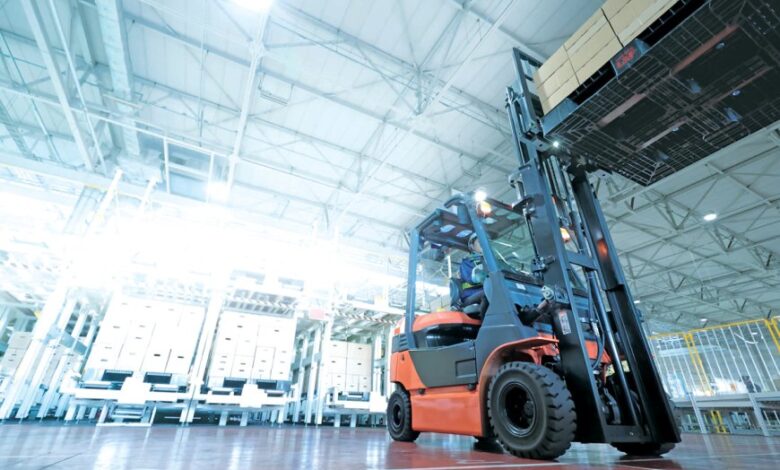Material Handling Equipment Innovations: The Latest Trends in Forklift Technology

The material handling industry is undergoing significant advancements, with new forklift technologies improving efficiency, safety, and sustainability. From electric powertrains to automation and telematics, businesses that adopt the latest innovations can enhance productivity while reducing operational costs. Keeping up with these trends ensures that warehouses, logistics companies, and manufacturing facilities remain competitive in an evolving market.
The Rise of Electric Forklifts
Electric forklifts are becoming the preferred choice for many businesses due to their efficiency and environmental benefits. As battery technology advances, these forklifts are providing longer operational hours and faster charging times.
1. Advantages of Electric Forklifts
- Lower Operating Costs: Reduced fuel and maintenance expenses compared to internal combustion forklifts.
- Zero Emissions: No exhaust fumes make them suitable for indoor use and environmentally friendly operations.
- Quiet Operation: Lower noise levels improve workplace conditions and reduce hearing-related risks.
- Regulatory Compliance: Many businesses are adopting electric forklifts to meet sustainability requirements and reduce their carbon footprint.
2. Lithium-Ion Battery Advancements
- Faster Charging: Lithium-ion batteries can charge in under two hours, minimizing downtime.
- Longer Lifespan: Increased durability means fewer replacements and lower costs over time.
- Consistent Power Output: Unlike lead-acid batteries, lithium-ion maintains steady performance throughout a shift.
- Reduced Maintenance Needs: Lithium-ion batteries require no water refilling and minimal servicing, reducing labor-intensive upkeep.
The Integration of Telematics and IoT in Forklifts
The use of telematics in forklifts is transforming fleet management by providing real-time insights into operations. Businesses leveraging this technology can track performance, schedule maintenance, and optimize routes.
1. How Telematics Enhances Fleet Management
- Real-Time Tracking: GPS and IoT integration help monitor forklift locations and movement.
- Automated Maintenance Alerts: Prevents unexpected breakdowns by providing diagnostic reports.
- Usage Analytics: Identifies underutilized forklifts to improve resource allocation.
- Fuel and Energy Monitoring: Allows businesses to track energy consumption and optimize usage to reduce costs.
2. Safety Enhancements with IoT
- Collision Detection Systems: Warn operators of potential hazards.
- Speed and Load Monitoring: Ensures operators follow safety protocols.
- Operator Access Control: Restricts usage to certified drivers, reducing accident risks.
- Remote Shutdown Capabilities: Enables managers to remotely disable forklifts in emergency situations.
Automation and Robotics in Material Handling
Automation is playing a growing role in forklift technology, with self-driving and semi-autonomous forklifts becoming more common. These innovations improve warehouse efficiency and reduce labor dependency.
1. Autonomous Forklifts
- AI and Machine Learning Integration: Enables forklifts to navigate complex warehouse layouts.
- Obstacle Avoidance Systems: Uses sensors and cameras to prevent collisions.
- Self-Charging Capabilities: Eliminates downtime caused by manual recharging.
- Automated Load Handling: Reduces the need for human intervention, improving overall efficiency.
2. Warehouse Robotics and Automated Guided Vehicles (AGVs)
- Fully Automated Pallet Handling: Reduces reliance on human operators.
- Integration with Warehouse Management Systems (WMS): Enhances inventory tracking and order fulfillment.
- Collaborative Robotics: Works alongside human workers to improve efficiency.
- Scalability for Growing Businesses: Allows warehouses to expand their automated systems as needed.
Sustainability Trends in Forklift Technology
Businesses are increasingly focusing on sustainability, and forklift manufacturers are introducing eco-friendly solutions to align with corporate environmental goals.
1. Hydrogen Fuel Cell Forklifts
- Rapid Refueling: Hydrogen-powered forklifts can be refueled in minutes, reducing downtime.
- Zero Emissions: Water vapor is the only byproduct, making them an environmentally friendly alternative.
- High Energy Efficiency: Ideal for high-intensity operations requiring continuous power.
- Long-Term Cost Savings: Reduces reliance on fossil fuels, stabilizing operational costs.
2. Recyclable and Eco-Friendly Materials
- Manufacturing with Sustainable Components: Reduces environmental impact during production.
- Battery Recycling Programs: Extends the lifecycle of lithium-ion and lead-acid batteries.
- Energy-Efficient Forklift Designs: Incorporates lightweight materials for improved performance.
- Solar-Powered Charging Stations: Further enhances the sustainability of electric forklift operations.
Enhancing Operator Experience with Smart Forklift Technology
New ergonomic designs and advanced operator-assistance systems are improving the user experience, making forklifts easier and safer to operate.
1. Smart Controls and Augmented Reality (AR) Displays
- Heads-Up Displays (HUDs): Provides real-time performance and inventory data to operators.
- Voice Command and Gesture Controls: Enhances efficiency by reducing manual input.
- Touchscreen Interfaces: Simplifies machine operation and navigation.
- Integrated AI Assistants: Provide on-the-go guidance and troubleshooting for operators.
2. Ergonomic Enhancements for Comfort and Safety
- Adjustable Seating and Controls: Reduces strain and fatigue during long shifts.
- Vibration Dampening Technology: Minimizes operator discomfort caused by rough surfaces.
- Advanced Climate Control Systems: Ensures optimal working conditions in extreme environments.
- Automated Seatbelt Detection: Ensures safety compliance by alerting operators to secure their restraints before use.
Choosing the Right Forklift Innovations for Your Business
With numerous advancements available, businesses must evaluate which technologies align with their operational needs. Tri-Lift Industries provides expert guidance on adopting the latest forklift innovations, ensuring seamless integration into existing workflows.
Key Considerations for Implementing New Technology:
- Operational Needs: Assessing whether automation, electric models, or telematics fit current processes.
- Cost vs. Long-Term Benefits: Evaluating upfront investment versus efficiency gains.
- Scalability: Ensuring chosen technologies can grow with the business.
- Training Requirements: Preparing operators for new systems and interfaces.
- Integration with Existing Systems: Verifying compatibility with warehouse management and logistics software.
Conclusion
The future of forklift technology is driven by automation, sustainability, and smart innovations that enhance efficiency and safety. Businesses that embrace these advancements will see improved productivity, lower operational costs, and greater environmental compliance. Whether through telematics, electric powertrains, or AI-driven automation, staying ahead of these trends ensures that material handling operations remain competitive. Tri-Lift Industries, Inc. offers the latest in forklift technology, helping businesses navigate these changes with expert support and customized solutions.




